WANDERING BETWEEN TWO WORLDS - by Dr. Edit Meraner
In life, as in nature, seasons mark our passage through time-from our beginning, our growth and transformation, and finally to our fading and vanishing. The life of Carla Carli has wandered through various seasons: beginning with her childhood in Appiano, her years of study in Venice and Milan, and her later years of study in a new world, the United States, where she received her Bachelors and Masters degrees.
And her journey continues: In the U.S. she has traveled the country from the Atlantic coast to the Pacific Ocean in California where she now lives. Her paintings have traveled as well, exhibited in galleries and museums from the Montserrat Gallery in New York to the Bowers Museum in California. And her commissioned work, “Evening at the Opera” graces the lobby of the Detroit Opera House in Michigan. The artist's wandering, however, has not solely been a geographic and artistic journey, it has also been a journey of the spirit. The colors of nature are mingled, in the artist's soul-the shadows of winter and the brightness of summer sun. They are the colors of the seasons and the cycle of our lives, which Carla Carli captures in her paintings. Her landscapes sway between joy and sadness, light and darkness, between the conscious and subconscious. It is this variation of tone in each of her paintings that creates an emotional dynamic held in balance by the strength of her composition.
In her painting, “Niagara Mist”, infinite shades of tinted whites hide and reveal the horizon. Dark clouds drift in the sky mingling with lighter ones, while the suggestion of sunlight reaches out from behind, revealing the course of the waters below. And like the subtle sunlight, the deeper significance of the painting is also suggested: Spirit, like the mist, floats ever changing, almost transparent between earth and sky, while the water's current flows along its eternal course, constant and unchanging.
Mazzucato
classic art — contemporary vision
Exhibit Review - Prisma Galerie (Bolzano, Italy) - 2006

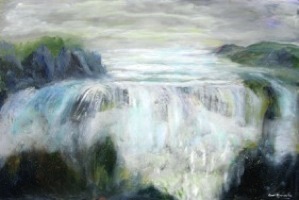
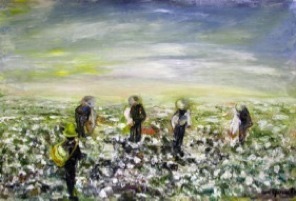
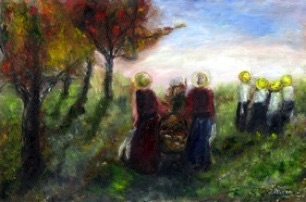
Niagara Mist
Sea of Cotton
Under the Autumn Sun
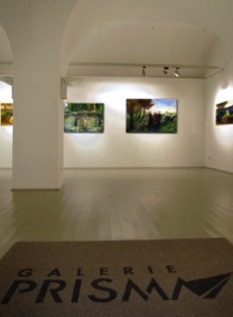
Similarly, “Sea of Cotton” is more than the depiction of a cotton plantation. It is a recurring verse in the song of America. Blacks work the old plantations just as now, in the West, Mexican migrant workers toil in the fields. The dark hues of the workers' clothing paints a tone of sadness that seems to echo even the recent suffering in New Orleans. Like the workers of the past, the victims of Hurricane Katrina faced adversity alone and abandoned in a sea of indifference.
In the painting “Under the Autumn Sun”, the trees reach toward the sky while a group of people gather beneath, unmindful of the end of Summer. Compositionally, the painting demonstrates Carla Carli Mazzucato's masterful technique. In the foreground of the painting, silhouetted figures stand with their backs to the viewer, moving away toward the horizon. It is as if a point of observation has been created within the painting, apart from the scene. It is not just a panorama; it is a scene with a point of view created by the subtle play of light that invites the imagination to wander with the figures toward the infinite horizon.
At one point in history, the term “midwest” was synonymous with the “prairie,” which eventually receded making way for the growth of American cities. Now, the prairie is all but gone, and the limitless expanse is only a nostalgic and distant memory. To rediscover the past, Carla Carli Mazzucato paints “American Prairie” with rich and bold colors and extends the landscape horizontally to recall the scope and silence of the lost land. It is a new place that the artist presents, and with no adherence to strict realism, she shows us a land that exists now only in dreams.
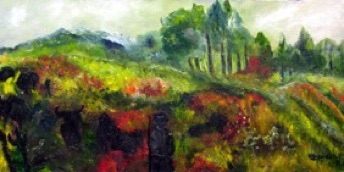
American Prairie
“Quiet Pool” is a painting without beginning or end—a fusion of time and world around us. The New York skyline, torn from the city that never sleeps, finds itself at rest, a timeless reflection in a pond in Central Park. It is in this city, where a sense of time is most powerful, that the future occurs and becomes one with the present. Carla Carli Mazzucato juxtaposes urban bustle with calmness, the cool colors of the city with those of nature—vibrant colors that fix moments in time with each gentle brush stroke.
In “The Quiet Season”, a melancholy tone is suggested, and yet a sense of hope comes through as well. The soothing calmness, however, is not created by golden sunlight from above; rather, it is the yellow hay in the fields that instills a sense of warmth.
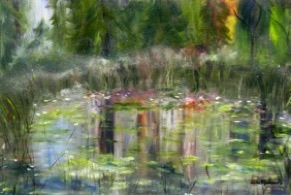
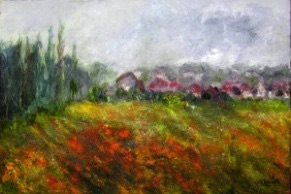
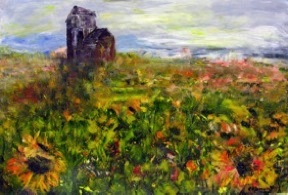
Quiet Pool
The Quiet Season
The Good Earth
The painting “The Good Earth” is both nostalgic and idyllic. It is a search for that place that gives refuge and protection, that place that brings joy for life in a time that is increasingly troubled. It is the search for this precious place, informed by years of life experience, both good and bad, that allows Carla Carli Mazzucato to paint her layered stories with seeming simplicity in a way that young artists cannot yet achieve. And we then must see beyond the simplicity to comprehend the artist's story.
The graceful and flowing style of Carla Carli Mazzucato's paintings on canvas is completely transformed when viewing her woodcut prints. From the openness and the sense of an indefinite horizon, we pass into a style that is both more confined and definite. The woodcut print is a medium that requires a more controlled form of artistic expression. The artist, however, is still able to successfully inscribe emotion into her prints.
In “Comfort”, feelings mingle: a sense of safety is rendered by a mother's embrace. “Landscape of My Life I” explores the artist's childhood and youth in Appiano, Italy; while, “Landscape of My Life II” discovers the city of her later years as a student in Detroit. Skyscrapers cut a dramatic line across the image, but in both landscapes the eye is drawn to the people that inhabit the scene. As with all her work, it is the human element that connects with us and speaks to us most profoundly.
translation: pvm
Prisma Galerie
Bolzano, Italy


